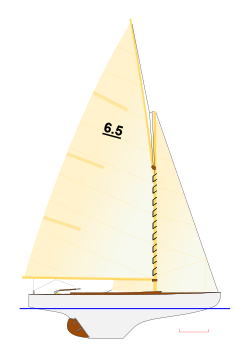This article needs additional citations for verification .(July 2025) |
 | |
| Development | |
|---|---|
| Design | Development class |
| Boat | |
| Crew | 3 |
| Draft | 1 m (3 ft 3 in) |
| Hull | |
| Hull weight | minimum 600 kg (1,300 lb) |
| LOA | 6.5 m (21 ft) |
| LWL | minimum 5.2 m (17 ft) |
| Rig | |
| Sails | |
| Upwind sail area | maximum 30 m2 (320 sq ft) |
The International 6.5 Metre Class is a sailing construction class. The boats are not identical but designed to meet specific measurement formula, in this case the French rule called Jauge chemin de fer .
